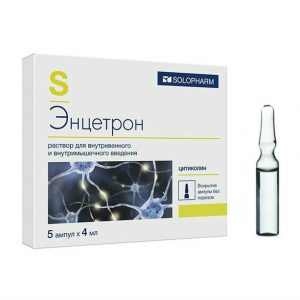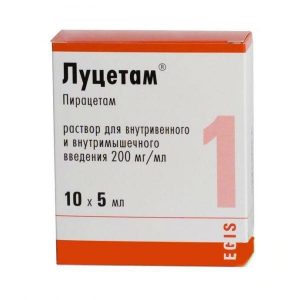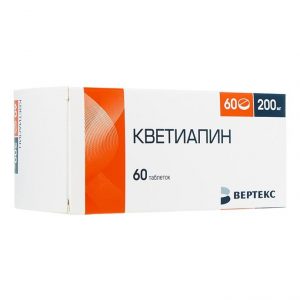Description
Pharmacological action
Pharmacotherapeutic group: Antipsychotic drug (antipsychotic)
ATX:
N.05.AH04 Quetiapine
Pharmacodynamics: Quetiapine is an atypical antipsychotic drug.
Quetiapine and its active metabolite, N-desalkylquetiapine (norquetiapine), interact with a wide range of brain neutrotransmitter receptors. Quetiapine and N-desalkylquetiapine exhibit a high affinity for 5HT2-serotonin receptors and D1 and D2-dopamine receptors in the brain. Antagonism to these receptors, combined with a higher selectivity for 5HT2-serotonin receptors than for D2-dopamine receptors, leads to clinical antipsychotic properties with affinity for 5HT1A-serotonin receptor, while N-desalkylquetiapine exhibits high affinity. Inhibition of the norepinephrine transporter and partial agonism towards 5HT1A-serotonin receptors, manifested by N-desalkylquetiapine, may cause an antidepressant effect. Quetiapine and N-desalkylquetiapine have a high affinity for histamine and 1-adrenergic receptors and moderate affinity for 2-adrenergic receptors.
In addition, quetiapine does not have or has a low affinity for muscarinic receptors, while N-desalkylquetiapine exhibits moderate or high affinity for several subtypes of muscarinic receptors, which may have anticholinergic (muscarinic-like) effects.
In standard tests, quetiapine exhibits antipsychotic activity. The specific contribution of the metabolite of N-desalkylquetiapine to the pharmacological activity of quetiapine has not been established. The results of a study of extrapyramidal symptoms (EPS) in animals revealed that quetiapine causes mild catalepsy in doses that effectively block D2 receptors. Quetiapine causes a selective decrease in the activity of mesolimbic A10-dopaminergic neurons in comparison with A9-nigrostriate neurons involved in motor function.
Effectiveness
Quetiapine is effective against both positive and negative symptoms of schizophrenia. Quetiapine is effective as monotherapy for manic episodes of moderate to severe severity.
There is no evidence of prolonged use of quetiapine for the prevention of subsequent manic and depressive episodes.
Data on the use of quetiapine in combination with valproate semisodium or lithium preparations for manic episodes of moderate to severe severity are limited, however, this combination therapy was generally well tolerated.
also quetiapine at a dose of 300 mg and 600 mg is effective in patients with bipolar disorder type I and II from moderate to severe severity. At the same time, the effectiveness of quetiapine when taken at a dose of 300 mg and 600 mg per day is comparable.
Quetiapine is effective in patients with schizophrenia and mania when taking the drug 2 times a day, despite the fact that the half-life of quetiapine is about 7 hours. The effect of quetiapine on 5HT2 and D2 receptors lasts up to 12 hours after taking the drug.
When taking quetiapine with a dose titration in schizophrenia, the incidence of EPS and the concomitant use of m-anticholinergic blockers were comparable to those with placebo. With the appointment of quetiapine in fixed doses from 75 to 750 mg / day for patients with schizophrenia, the incidence of EPS and the need for concomitant use of m-anticholinergic drugs did not increase.
When quetiapine was used in doses of up to 800 mg / day for the treatment of moderate to severe manic episodes, both as monotherapy and in combination with lithium preparations or semisodium valproate, the incidence of EPS and the concomitant use of m-anticholinergic blockers was comparable to that for taking a placebo.
Pharmacokinetics: The pharmacokinetics of quetiapine are linear there are no differences in pharmacokinetic parameters between men and women.
Absorption
When administered, quetiapine is well absorbed from the gastrointestinal tract. Food does not significantly affect the bioavailability of quetiapine.
Distribution of
Plasma Protein Binding – approximately 83%. Peak molar concentrations in the equilibrium state of the active metabolite of N-desalkylquetiapine account for 35% of those observed for quetiapine.
Metabolism
Quetiapine is extensively metabolized in the liver. The CYP3A4 isoenzyme was found to be a key isoenzyme of CYP-mediated quetiapine metabolism. The main metabolites in the plasma do not have pronounced pharmacological activity. Quetiapine and some of its metabolites have weak inhibitory activity against the isoenzymes CYP1A2, CYP2C9, CYP2C19, CYP2D6 and CYP3A4, but only at a concentration 10-50 times higher than the concentrations observed at the usual effective dose of 300-450 mg / day.
Excretion
The elimination half-life of quetiapine and N-desalkylquetiapine is approximately 7 and 12 hours, respectively. Approximately 73% of quetiapine is excreted in urine and 21% in feces. Less than 5% of quetiapine is not metabolized and excreted unchanged by the kidneys or with feces.
Pharmacokinetics in special clinical cases
The average plasma clearance of quetiapine is less than about 25% in patients with severe renal failure (CC <30 ml / min / 1.73 m2) and in patients with liver damage (compensated alcoholic cirrhosis), but individual indicators of clearance are in the range corresponding to healthy people. The average clearance of quetiapine in elderly patients is 30-50% less than in patients aged 18 to 65 years. In a study of healthy volunteers, concomitant use with ketoconazole led to an increase in Cmax and AUC of quetiapine by 235% and 522%, respectively, with a corresponding decrease in average clearance by 84% when taken orally. The elimination half-life of quetiapine increased from 2.6 to 6.8 hours, but the average maximum elimination half-life (Tmax) remained unchanged. Indications Treatment of acute and chronic psychoses, including schizophrenia. Treatment of manic episodes in the structure of bipolar disorder. Treatment of moderate to severe depressive episodes in the structure of bipolar disorder. The drug is not indicated for the prevention of manic and depressive episodes. Contraindications Hypersensitivity to any component of the drug. Co-administration with cytochrome P450 inhibitors such as azole antifungals, erythromycin, clarithromycin and nefazodone, as well as HIV protease inhibitors. Children under 18 years of age (efficacy and safety not established). Lactose intolerance, lactase deficiency, glucose-galactose malabsorption. Caution: In patients with cardiovascular and cerebrovascular diseases or other conditions predisposing to arterial hypotension, advanced age, liver failure, a history of seizures, the risk of stroke and aspiration pneumonia. Use during pregnancy and lactation Pregnancy Safety and effectiveness of quetiapine in pregnant women have not been established. Therefore, during pregnancy, quetiapine can only be used if the expected benefit for the woman justifies the potential risk to the fetus. When using antipsychotic drugs, including quetiapine, in the third trimester of pregnancy, newborns are at risk of developing adverse reactions of varying severity and duration, including EPS and / or withdrawal syndrome. Excitation, hypertension, hypotension, tremors, drowsiness, respiratory distress syndrome, or feeding disorders. In this regard, the condition of newborns should be carefully monitored. Breastfeeding period Quetiapine is excreted in breast milk, but the degree of excretion has not been established. Women should be advised to avoid breastfeeding while taking quetiapine. Special instructions Children and adolescents (ages 10 to 17) Quetiapine is not indicated for use in children and adolescents under the age of 18 due to insufficient data on its use in this age group. According to the results of clinical studies of quetiapine, some side effects (increased appetite, increased serum prolactin concentration, vomiting, runny nose and fainting) were observed in children and adolescents with a greater frequency than in adult patients. Some side effects (EPS) in children and adolescents can have different consequences compared to adult patients. An increase in blood pressure was also observed, which was not observed in adult patients. In children and adolescents, a change in thyroid function was also observed. Effect on growth, puberty, mental development and behavioral reactions with prolonged use (more than 26 weeks) of quetiapine have not been studied. In a placebo-controlled study in children and adolescents with schizophrenia and mania in the structure of bipolar disorder, the incidence of EPS was higher with quetiapine compared with placebo. Suicide / Suicidal thoughts or clinical worsening Depression in bipolar disorder is associated with an increased risk of suicidal thoughts, self-harm, and suicide (suicide-related events). This risk remains until the onset of severe remission. Due to the fact that several weeks or more may elapse from the start of treatment, patients should be closely monitored until improvement occurs. According to generally accepted clinical experience, the risk of suicide may increase in the early stages of remission. Patients (especially those at high risk of suicide) and their caregivers should be warned about the need to control clinical deterioration, suicidal behavior or thoughts, unusual changes in behavior and the need to immediately consult a doctor if they occur. According to clinical studies in patients with depression in bipolar disorder, the risk of suicide-related events was 3.0% (7/233) for quetiapine and 0% (0/120) for placebo in patients aged 18-24 years 1.8% (19/1616) for quetiapine and 1.8% (11/622) for placebo for patients older than 25 years. Other mental disorders for which quetiapine is prescribed, also associated with an increased risk of suicide-related events. In addition, such conditions can be comorbid with a depressive episode. Thus, the precautions used in the treatment of patients with a depressive episode should be taken when treatingPatients with other mental disorders. When quetiapine is abruptly discontinued, the potential risk of suicide-related events should be considered. Patients with a history of suicidal events, as well as patients who clearly express suicidal thoughts before starting therapy, are at increased risk for suicidal intent and suicidal attempts and should be carefully observed during treatment. A FDA (Food and Drug Administration, USA) meta-analysis of placebo-controlled studies of antidepressants, summarizing data from approximately 4400 children and adolescents and 7700 adult patients with mental disorders, revealed an increased risk of suicidal behavior against antidepressants compared to placebo in children , adolescents and adult patients under the age of 25 years. This meta-analysis does not include studies using quetiapine. According to short-term placebo-controlled studies for all indications and in all age groups, the frequency of suicide-related events was 0.8% for both quetiapine (76/9327) and placebo (37/4845). In these studies in patients with schizophrenia, the risk of suicide-related events was 1.4% (3/212) for quetiapine and 1.6% (1/62) for placebo in patients aged 18-24 years. 0 8% (13/1663) for quetiapine and 1.1% (5/463) for placebo in patients older than 25 years 1.4% (2/147) for quetiapine and 1.3% (1/75) for placebo patients under the age of 18 years. In patients with mania with bipolar disorder, the risk of developing suicide-related events, was 0% (0/60) for quetiapine and 0% (0/58) for placebo in patients aged 18-24 years, 1.2% (6/496) for quetiapine and 1.2% (6/503) for placebo in patients older than 25 years, 1.0% (2/192) for quetiapine and 0% (0/90) for placebo in patients under the age of 18 years. Drowsiness Drowsiness and related symptoms, such as sedation, may occur during quetiapine therapy. In clinical trials involving patients with depression in the structure of bipolar disorder, drowsiness typically developed during the first three days of therapy. The severity of this side effect was mainly mild or moderate. With the development of severe drowsiness, patients with depression in the structure of bipolar disorder may require more frequent visits to the doctor within 2 weeks from the onset of drowsiness or to reduce the severity of symptoms. In some cases, discontinuation of quetiapine therapy may be required. Patients with cardiovascular disease Caution should be exercised when prescribing quetiapine to patients with cardiovascular and cerebrovascular diseases, and other conditions predisposing to hypotension. Orthostatic hypotension may occur during quetiapine therapy, especially during dose titration at the start of therapy. Orthostatic hypotension and dizziness associated with it can increase the risk of accidental injury (fall), especially in elderly patients. Patients should be careful until they adapt to these potential side effects. If orthostatic hypotension occurs, a dose reduction or slower titration may be required. Sleep Apnea Syndrome In patients taking quetiapine, sleep apnea was noted. Caution should be exercised when prescribing quetiapine to patients receiving drugs that have a depressing effect on the central nervous system, as well as to patients with risk factors for sleep apnea (for example, overweight / obesity, male gender) or with a history of sleep apnea. Convulsive seizures There were no differences in the incidence of seizures in patients taking quetiapine or placebo. However, as with other antipsychotic drugs, caution is recommended when treating patients with quetiapine with a history of seizures. Extrapyramidal symptoms An increase in the incidence of EPS in adult patients with depression in the structure of bipolar disorder when taking quetiapine for depressive episodes compared with placebo was noted. Against the background of taking quetiapine, akathisia may occur, which is characterized by an unpleasant feeling of motor anxiety and the need to move, and is manifested by the patient’s inability to sit or stand motionless. If such symptoms occur, do not increase the dose of quetiapine. Tardive dyskinesia In case of symptoms of tardive dyskinesia, it is recommended to reduce the dose of the drug or to stop it gradually. Symptoms of tardive dyskinesia may worsen or even occur after discontinuation of the drug. Malignant antipsychotic syndrome Along with taking antipsychotic drugs, including quetiapine, malignant antipsychotic syndrome may develop. Clinical manifestations of the syndrome include hyperthermia, altered mental status, muscle rigidity, autonomic nervous system lability, and an increase in creatine phosphokinase activity. In such cases, quetiapine must be discontinued and appropriate treatment given. Severe neutropenia and agranulocytosis In short-term placebo-controlled clinical trials of quetiapine monotherapy, cases of severe neutropenia (neutrophil count <0.5 x 109 / L) without infection were infrequent. The development of agranulocytosis (severe neutropenia associated with infections) was reported in patients receiving quetiapine in clinical trials (rarely), as well as in post-marketing use (including death). Most of these cases of severe neutropenia occurred several months after the initiation of quetiapine therapy. No dose-dependent effect was detected. Leukopenia and / or neutropenia resolved after quetiapine therapy was discontinued. A possible risk factor for neutropenia is a previous low white blood cell count and a history of drug-induced neutropenia. The development of agranulocytosis was also noted in patients without risk factors. It is necessary to consider the possibility of developing neutropenia in patients with infection, especially in the absence of obvious predisposing factors, or in patients with unexplained fever, these cases should be managed in accordance with clinical recommendations. In patients with neutrophil counts <1.0 x 109 / L, quetiapine should be discontinued. The patient must be monitored to identify possible symptoms of infection and to monitor the level of neutrophils (to exceed the level of 1.5 x 109 / l). Impact on the ability to drive transp. Wed and fur.: Quetiapine may cause drowsiness, dizziness, and other adverse drug reactions from the central nervous system. Therefore, at the first stages of treatment, during an individually determined period of time, the patient should be prohibited from driving vehicles or servicing operating mechanical devices. Composition Active ingredient: quetiapine fumarate – 172,700 mg in terms of quetiapine -150,000 mg. Excipients (core): microcrystalline cellulose – 109,600 mg lactose monohydrate – 31,050 mg povidone type K-17 – 15,000 mg carboxymethyl starch sodium (primogel) – 27,000 mg calcium hydrogen phosphate dihydrate – 15,000 mg magnesium stearate – 4,650 mg. Film coating: WVACOAT ® PA-3P-261 finished film coating system – 9,400 mg [hypromellose (EPMC) 6 / E464 – 3,666 mg, titanium dioxide / E171 – 2,804 mg, polydexgroza / E1200 – 1,410 mg, talc / E553b – 0,940 mg mg, macrogol 3350 – 0.564 mg, iron dye oxide red / E172 – 0.016 mg]. Dosage and administration Inside, regardless of food intake. Treatment of acute and chronic psychoses, including schizophrenia Quetiapine is prescribed twice a day. The daily dose for the first 4 days of therapy is: 1st day – 50 mg, 2nd day – 100 mg, 3rd day – 200 mg, 4th day – 300 mg. Starting on day 4, the dose should be titrated to effective, usually in the range of 300 to 450 mg / day. Depending on the clinical effect and individual tolerance of the drug to the patient, the dose can vary from 150 to 750 mg / day. The maximum recommended daily dose is 750 mg. Treatment of manic episodes in the structure of bipolar disorder Quetiapine is used as monotherapy or as an adjuvant therapy to stabilize mood. Quetiapine is prescribed twice a day. The daily dose for the first 4 days of therapy is: 1st day – 100 mg, 2nd day – 200 mg, 3rd day – 300 mg, 4th day – 400 mg. In the future, by the 6th day of therapy, the daily dose of the drug can be increased to 800 mg. The increase in the daily dose should not exceed 200 mg per day. Depending on the clinical effect and individual tolerance, the dose can vary from 200 to 800 mg / day. Typically, an effective dose is 400 to 800 mg / day. The maximum recommended daily dose is 800 mg. Treatment of depressive episodes in the structure of bipolar disorder Quetiapine is prescribed once a day at night. The daily dose for the first 4 days of therapy is: 1st day – 50 mg, 2nd day – 100 mg, 3rd day – 200 mg, 4th day – 300 mg. The recommended dose is 300 mg / day. The maximum recommended daily dose is 600 mg. There was no clinical improvement with increasing doses of more than 600 mg / day. To maintain remission, it is advisable to use the lowest dose. Patients should be periodically examined to determine the need for maintenance therapy. When resuming therapy less than 1 week after discontinuation, administration can be continued at a dose adequate for maintenance therapy. When resuming therapy in patients who have not received quetiapine for more than 1 week, the rules for initial dose selection should be followed and the effective dose should be established according to the clinical response of the patient. In elderly patients, the initial dose of quetiapine is 25 mg / day. The dose should be increased daily by 25-50 mg to achieve an effective dose, which is likely to be less than in young patients. In patients with hepatic insufficiency, it is recommended to start therapy with 25 mg / day. It is recommended to increase the dose daily by 25-50 mg until an effective dose is achieved. Drug Interactions Caution should be exercised when the combined use of quetiapine with other drugs that affect the central nervous system, as well as with alcohol. Caution should be exercised when combined with quetiapine and other drugs with anticholinergic (muscarinic) effects. Cytochrome P450 isoenzyme (CYP) ZA4 is the main isoenzyme responsible for the metabolism of quetiapine via the cytochrome P450 system. In healthy volunteers, the combined use of quetiapine (at a dose of 25 mg) with ketoconazole, an inhibitor of the CYP3A4 isoenzyme, increased the area under the concentration-time (AUC) curve of quetiapine by 5-8 times. Therefore, the combined use of quetiapine and inhibitors of the CYP3A4 isoenzyme is contraindicated. It is also not recommended to use quetiapine with grapefruit juice. In a pharmacokinetic study with repeated administration of quetiapine prior to or simultaneously with carbamazepine, a significant increase in the clearance of quetiapine and, consequently, a decrease in AUC by an average of 13% compared with taking quetiapine without carbamazepine. In some patients, the decrease in AUC was even more pronounced. This interaction is accompanied by a decrease in the concentration of quetiapine in plasma and may reduce the effectiveness of quetiapine therapy. The combined use of quetiapine with phenytoin, another inducer of microsomal liver enzymes, was accompanied by an even more pronounced (about 450%) increase in the clearance of quetiapine. The use of quetiapine in patients receiving inducers of microsomal liver enzymes is possible only if the expected benefits of quetiapine therapy outweigh the risk associated with discontinuation of the drug-inducer of microsomal liver enzymes. Changing the dose of inducer preparations of microsomal liver enzymes should be gradual. If necessary, it is possible to replace them with drugs that do not induce microsomal liver enzymes (for example, valproic acid preparations). The pharmacokinetics of quetiapine did not change significantly with the simultaneous use of the antidepressant imipramine (inhibitor of the isoenzyme CYP2D6) or fluoxetine (inhibitor of the isoenzyme CYP3A4 and CYP2D6). The pharmacokinetics of quetiapine do not significantly change when used simultaneously with antipsychotic drugs risperidone or haloperidol. However, the simultaneous use of quetiapine and thioridazine led to an increase in clearance of quetiapine by about 70%. The pharmacokinetics of quetiapine does not significantly change with the simultaneous use of cimetidine. With a single dose of 2 mg of lorazepam while taking quetiapine at a dose of 250 mg 2 times a day, the clearance of lorazepam is reduced by about 20%. The pharmacokinetics of lithium ns preparations change with the simultaneous use of quetiapine. There were no clinically significant changes in the pharmacokinetics of valproic acid and quetiapine with the combined use of valproate semisodium and quetiapine. Pharmacokinetic studies to study the interaction of quetiapine with drugs used in cardiovascular diseases have not been conducted. Caution should be exercised in the combined use of quetiapine and drugs that can cause electrolyte imbalance and lengthen the QTc interval. Quetiapine did not induce the induction of microsomal liver enzymes involved in phenazone metabolism. In patients taking quetiapine, false-positive results of screening tests for the detection of methadone and tricyclic antidepressants by enzyme-linked immunosorbent assay were observed. A chromatographic study is recommended to confirm the screening results. Overdose of Fatal outcome was reported with 13.6 g of quetiapine in a patient who participated in the clinical trial, as well as fatal outcome after taking 6 g of quetiapine in a post-marketing study of the drug. At the same time, a case of taking quetiapine in a dose is described, exceeding 30 g, without death. There are reports of extremely rare cases of an overdose of quetiapine, leading to an increase in the QTc interval, death or coma. In patients with a history of severe cardiovascular disease, the risk of developing side effects with an overdose may increase. Symptoms noted in case of overdose were mainly the result of increased known pharmacological effects of the drug, such as drowsiness and sedation, tachycardia, decreased blood pressure and anticholinergic effects. Storage conditions In the dark place at a temperature of no higher than 25 ° C. Keep out of the reach of children. Expiration 3 years. Deystvuyuschee substances quetiapine Form of Treatment tablets




